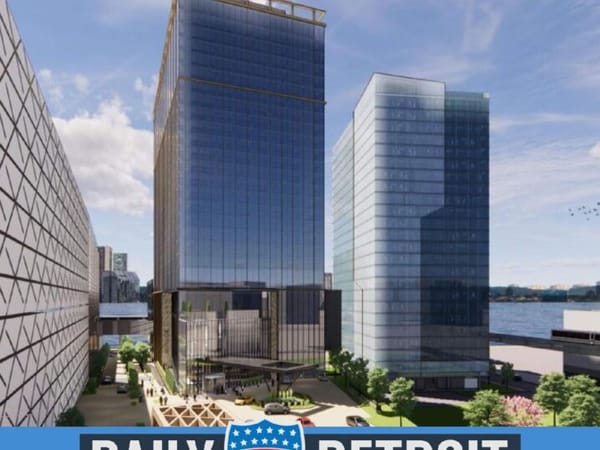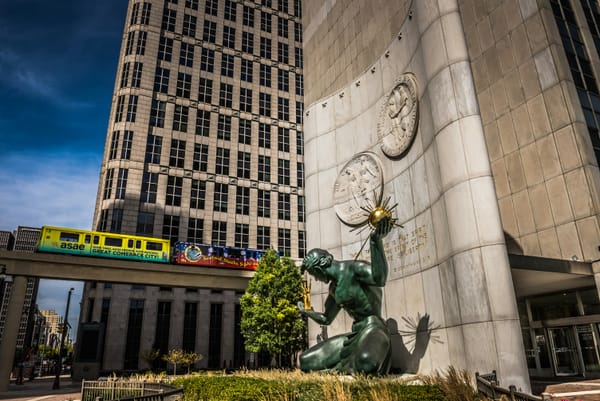This year at the Detroit Policy Conference, the fifth annual gathering of more than 800 business and community leaders at the Motor City Casino, we left with way more questions than answers.
That’s actually not a bad thing. The dynamic ideations of some of Detroit’s finest thinkers left everyone talking about both how incredibly far the city has come in recent years, but also, thinking about how much further we have to go in regard to the myriad issues still facing the city.
There were countless quotes and memorable moments throughout the day — far more than we can document in full (we’ll post the videos when they become available) — but we’ve pulled some of what we believe to be the key take-aways of the day to share with you.
We hope that these messages make their way into your neighborhood bar, dinner table, or office water cooler discussion this week, and that you’re inspired to do what you can to help find meaningful answers to some of these massive questions that seemed to focus around two ideas: Detroit still needs to work on the basics, and that there are tensions felt in the city.

DPS and adult education programs need to create strong programming to cultivate a deep level of understanding about financial literacy
According to panelists John Hope Bryant of Bryant Group Ventures, and Crystal Nickson with HOPE Inside-Detroit, without a foundation of knowledge around this financial literacy our children are at a significant disadvantage in the ability to create a long term vision for themselves as successful and financially secure adults.
It’s also critical to provide the same opportunity for adults, especially parents. By enhancing financial literacy in parents you create role models who have the ability to inspire their children to follow the same path. Role models and leaders play a critical role in building a thriving community, and without effective educational programing to help empower individuals to take on such roles, the cycle of poverty can never be broken.

Development requires a focus on creating comprehensive live work and play communities both in the city center and in the neighborhoods
Gwendolyn Butler, a developer and partner in the Capri Investment Group, spoke on the issues that Detroit lacks 24/7 live work and play communities and that to remedy the situation development must focus on creating just that. Citing successful examples like The Vermont in Korea Town neighborhood of Los Angeles and Kingsbury Plaza in Chicago, she concluded that such developments can and should replace existing parking lots, abandoned buildings, and the like.
It is developments such as these that will create fully functional neighborhoods which will drive business and further residential developments on the area, resulting in strong neighborhoods.

When it comes to building neighborhoods, homebuyers/occupants are exponentially more beneficial than investors
The storyline of investors swooping up buildings downtown is nothing new, but how does this play out in real estate in the neighborhoods? A number of organizations are exploring this issue and have found that investors buying up 20 homes in a developing neighborhood might not be the best long term solution to the neighborhood woes facing Detroit.
The Detroit Land Bank Authority, for example, own the deeds to 15-20 thousand homes, many of which are set to be auctioned off for ownership. Craig Fahle, The Land Bank Authority’s Director of Public Affairs, noted that what really makes a difference is when folks buy a home that they actually intend to live in, rather than looking at it as piece of property they will sell off when the price is right.
Home occupancy, not just ownership, will drive further development because residents will drive demand for businesses like grocery stores and retail — resulting in thriving, full developed neighborhoods bustling with life.

Economic diversity creates a more robust business sector and more job opportunities
It has been well documented that Detroit’s reliance on the auto industry was one of the most critical factors in the city’s downfall, and today, the city is facing a similar situation in terms of economic diversity. Despite the Detroit Three’s resurgence in the last several years, in order to become a true economic leader in the U.S., the economic landscape in Detroit must diversify.
The technology sector is growing, as is health care and even the food industry, but it’s not enough. To thrive, we must develop our reputation as a city that is open to any and all types of industry in order to create the economic diversity that will result in sustained growth and economic prosperity.
Love the @RocketFiber truck perfectly placed at #DPC16 @DetroitChamber pic.twitter.com/zNOthGgVGV
— Kevin Ketels (@Kevin_Ketels) February 24, 2016
Lack of Internet connectivity is a significant barrier to human potential in the neighborhoods
The significant lack of Internet connectivity outside the downtown and midtown areas is a no secret. For years, well over half of the city has been without access to Internet, and several organizations have sprung up to remedy the issue. This complex problem appears to stem from a chicken or the egg conundrum.
One side says that providers avoid offering service in areas with high numbers of foreclosures, or areas that are notorious for poverty and economic hardship, leaving residents without access to the Internet, and creating an exclusionary system which hinders their ability to apply for jobs, or students to do school work, and other activities that connected areas have access to.
Existing providers, on the other hand, argue that even with programs like Comcast’s Internet Essentials — which provides Internet access in such areas for less than $10 per month — residents are not actually demanding service and that’s the reason they don’t have customers in these areas.
A representative from Comcast noted that in some cases, residents aren’t well-informed on the value of Internet access, which she believed may be the reason behind lack of demand.
Whatever the case, this is a critical issue that falls under the umbrella of unresolved issues that exist in the neighborhoods of Detroit. When it comes to the jobs of today and the future, if you don’t have basic computer skills, you’re basically lost.

Lots of talk on transit, little leaving the station so far
Another item was transit — the intersection of tensions of race and generation are at play there, too. More and more, young people aren’t as enamored with the car, and they’re choosing cities with mass transit but we can’t seem get off the mark.
Melissa Roy from Advance Macomb who is also the head of SMART (the suburban bus system) talked about how she believes SMART are good stewards of the money there is — but we don’t spend as a region on transit, so we can’t do very much. An upcoming regional millage would aim to fix that. She also highlighted how we have untapped economic potential — and that makes sense as studies show that mass transit access is directly tied to economic mobility (i.e. people getting out of poverty).
Although there has been progress with the construction of the much-talked about M1 Rail, it’s key to remember it’s a considered a neighborhood circulator to help connect greater downtown Detroit, not a regional transit solution.

“New” Detroit, new tensions
Detroit’s comeback has an undercurrent of tension, and out of the conference it was clear that it’s not just racial, but also generational. Some tensions — Downtown vs. the Neighborhoods, for instance — have been debated for decades, and probably will be for decades more.
Today, things are changing in the city. The addition of new, affluent residents mixed with the ongoing trend of black middle class residents moving to suburbs is increasing friction with those who have stayed — as well as there has been a mostly undercovered large increase in the Hispanic population.
Mayor Dave Bing pulled few punches with his comments about inclusion, which raised an interesting question — should we even view the city as multiple Detroits — 2, or 3, or 695,000 — or maybe, instead of the divisiveness going on, should we view it as a city that needs to be inclusive work together as ONE Detroit? After all, there was much talk about how African Americans often feel excluded from the city’s renaissance, but less about the one population that’s been growing in Detroit, the Hispanic population. It grew 70 percent from 1990-2010, while everyone else was leaving en masse.
There’s also what feels like new tension point — one that is generational. There’s a feeling that many new “millennial” or “younger” residents (read: under 35) want to make the city (or any place they move or work, it’s really not just about Detroit) “their own.” That feels insulting to many people already here who want new folks to come; however they’d like them to plug in and work with what’s already going on.
Lauren Hood, Director of the Live6 Initiative, put it bluntly:
There are NO blank slates in Detroit. Every place has a story/culture already even if they aren’t good at telling it -Lauren Hood #DPC16
— C.D. Jamerson (@CDJamerson) February 24, 2016
Her point was that if you move in, it’s not your own, you should explore what’s there and then see how you can develop it with whatever resources you bring to the table, and add to the existing sense of community rather than trying to mold it to your vision.
The policy conversation as far as the Detroit Regional Chamber goes will continue at the Mackinac Policy Conference at the end of May. But the discussion around all of these topics should be ongoing — what do you think?









